Resources
December 5, 2024 · Last updated on May 19, 2025
Sales Battlecards 101
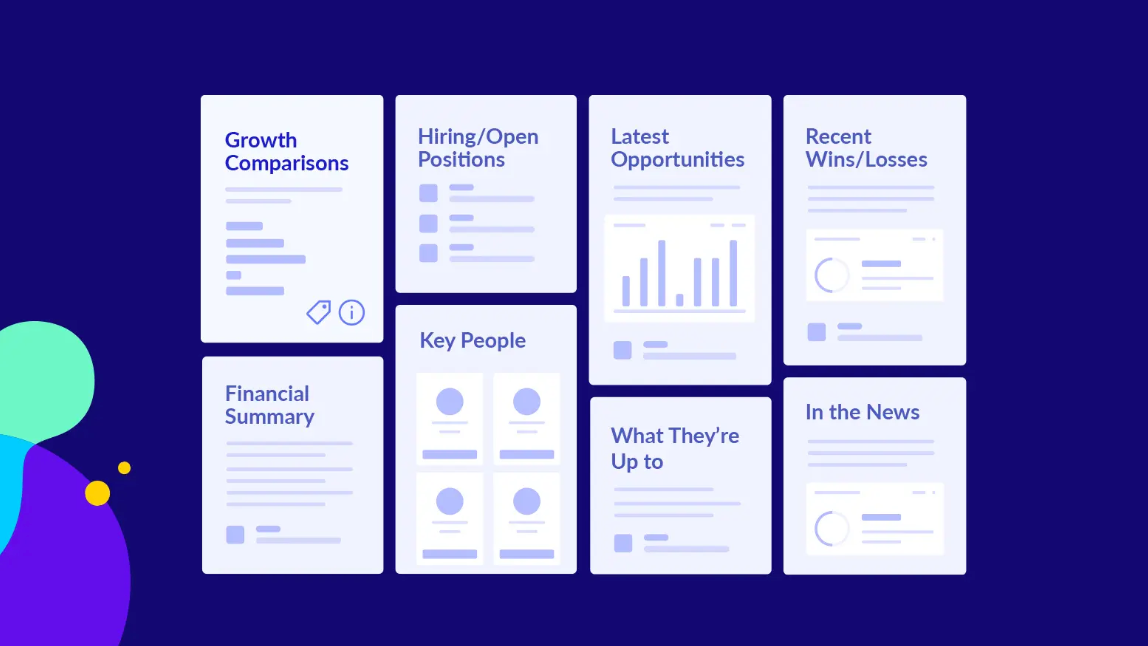
# battlecards
Expert Guide + Battlecard Templates

Niko Pajkovic

Sales battlecards have become an essential weapon for reps facing tough competition and savvy buyers.
In our experience, the right battlecard, leveraged at the right moment, can make the difference between winning and losing a deal.
But here’s the catch: creating battlecards that sales teams actually use is where organizations stumble. It’s not enough to have battlecards; they need to be effective, up-to-date, and genuinely useful in the heat of a sales conversation.
To address this challenge, we’ve created this guide, which offers a research-backed approach to building better battlecards.
We’re not here to rehash generic advice. Instead, we’re sharing the specific methods we employ at Klue when building our very own competitive battlecards.
Let’s dive in.
Oh – and if you’re short on time, we have six fillable battlecard templates you can download now for free. Grab them here.
What is a Battlecard?
A sales battlecard is a concise, strategic document that equips sales reps with key information about their competitors’ products and services. They are used to boost the effectiveness of your sales team by providing reps with instant access to critical information so they can respond quickly and knowledgeably to customer questions.
Sales battlecards typically include:
- Key features and benefits of your own product
- Key features and benefits of your competitor’s product
- Common buyer objections and how to handle those objections
- Talk tracks for specific competitor-related questions
When implemented correctly, battlecards can significantly improve win rates and optimize the sales process.
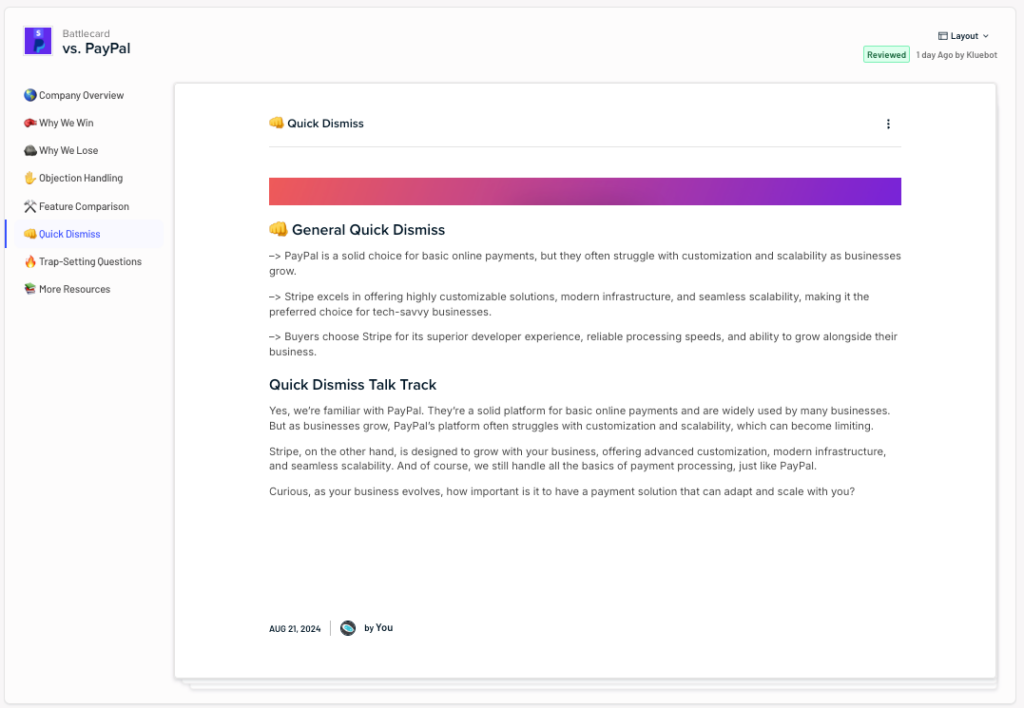
Example of a Klue ‘Quick Dismiss” battlecard
The Role of Battlecards in Competitive Intelligence and Sales Enablement
Battlecards serve as the bridge between market/competitor intelligence and sales execution. Because of this, they are one of the most potent tools you can leverage in your product marketing, competitive intelligence, and sales enablement strategies.
By transforming complex competitive dynamics into digestible insights, battlecards help your sales reps to:
- Quickly access key information during crucial conversations with prospects
- Confidently handle objections and competitor comparisons
- Present your product’s strengths in context to your competitive landscape
Why is this so important?
Without effective battlecards, sales teams may struggle to articulate your product’s unique value proposition or counter your competitor’s strengths. This can lead to lost deals, longer sales cycles, and frustrated reps.
Types of Battlecards
There are dozens of battlecard templates out there, each of which serves a unique purpose. (We’ve compiled a list of 15 examples at the bottom of this blog for your reference.) However, if you’re looking for more strategic focus, you can consolidate these into four primary battlecard ‘types.’
BDR Battlecards
Discovery-focused, these battlecards help reps understand core consumer needs and swat away competitors early in the deal. They typically include probing questions to facilitate discussions around common prospect pain points. Additionally, they’re used to construct an ‘us vs them’ framework, highlighting your winning features and key differentiators from the outset.
Card Examples: Why We Win, Why We Lose
Sales Battlecards
These are tactically focused on depositioning competitors late in the sales cycle. They arm reps with specific talking points, objection-handling techniques, and competitive advantages to leverage in late-stage conversations.
Card Examples: Quick Dismiss, Trap Setting Questions, Objection Handling
Product Battlecards
These battlecards dive deep into product feature sets and future road maps. They help reps articulate your product’s unique value proposition, technical specifications, and upcoming innovations.
Card Examples: Feature Comparison, Pricing
Executive Battlecards
These provide a high-level snapshot of the competitor, including their strengths, weaknesses, and recent developments. They’re perfect for quick reference in executive-level discussions.
Card Examples: Company Overview, Approach to Market
How Do Teams Actually Use Sales Battlecards?
In practice, sales teams leverage battlecards in various ways depending on their experience level and the specific sales scenario. Newer reps often rely on battlecards as a real-time reference during calls, quickly pulling up competitor information or objection handling tips when needed.
More seasoned pros tend to use battlecards as a periodic refresher, checking them before important calls or when they encounter a competitor they haven’t faced in a while. This group particularly values battlecards that are up to date with the latest intel.
But Where Are They Stored and Managed?
This can vary widely. Some teams still use traditional methods, such as spreadsheets or PowerPoint decks stored on shared drives. Others will keep their battlecards tied to a main competitive landscape analysis document.
Meanwhile, many compete pros have adopted a more sophisticated competitive intelligence software like Klue 😉, which speeds up and consolidates the process of creating, updating, and accessing battlecards
The Key to a 10/10 Battlecard?
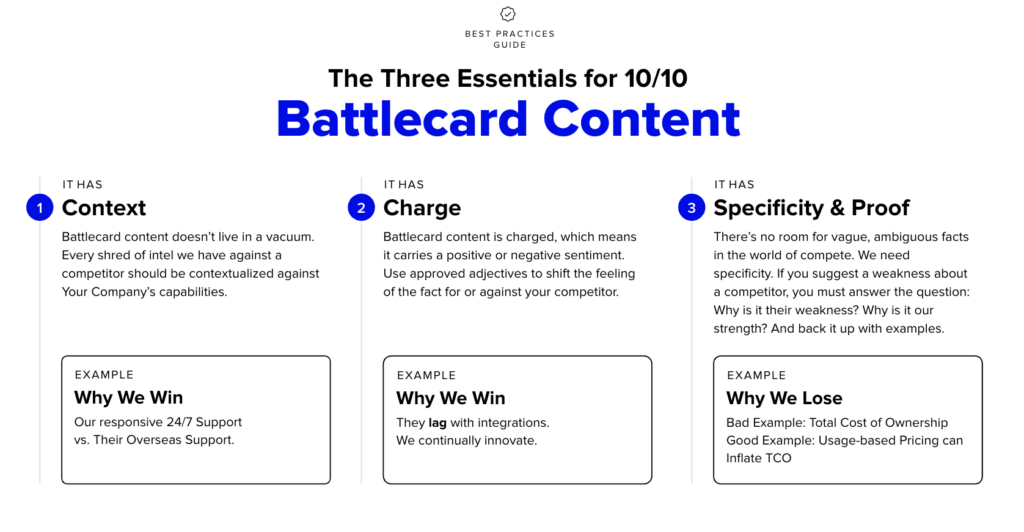
The way you present information on your battle cards is just as important as the information itself. Here are three must-haves for creating top-tier battlecard content.
Context
Don’t just state facts about a competitor in isolation; always provide the “so what?” for your offering.
Example: Instead of simply stating “Competitor X offers next-day shipping,” say “While Competitor X offers next-day shipping, our same-day delivery service ensures customers receive their products even faster, improving their experience and satisfaction.”
Charge
Avoid neutral language. Give your content a positive or negative charge to guide your sales team’s positioning. Instead of just listing a feature, describe how it “expedites” a process or “eliminates” a common pain point.
Example: Instead of “We offer automated reporting,” say “Our automated reporting feature slashes administrative overhead, freeing up your team to focus on strategic initiatives.”
Specificity
Vague statements don’t win deals. Be as specific as possible in your comparisons and claims.
Example: Instead of saying “We have better performance,” provide concrete metrics: “Our solution processes transactions 50% faster than Competitor Y, reducing wait times from 10 seconds to under 5 seconds.”
Sales Battlecard Examples: What Does a Winning Card Actually Look Like?
Theory is great, but now it’s time to get practical. What does an effective battlecard look like in the real world?
To illustrate, we’ve created two hypothetical examples featuring Pied Piper competing against Stripe. These examples will show you how to structure your battlecards for maximum impact.
Sales Battlecard Example #1: The ‘Why We Win’ Card
The “Why We Win” battlecard showcases your key competitive advantages against a specific competitor. It provides sales reps with clear, credible talking points for competitive situations.
As you can see in the example below, we’ve structured this card into three categories.
- Fact – The context around the card, its title, and the competitive insight.
- Impact – Why does this competitive insight matter? In this case, why is this a reason that we win deals and in what cases can a seller best use it?
- Act – The relevant actions a seller can take. These can be talk tracks, questions to ask, and relevant follow-ups.
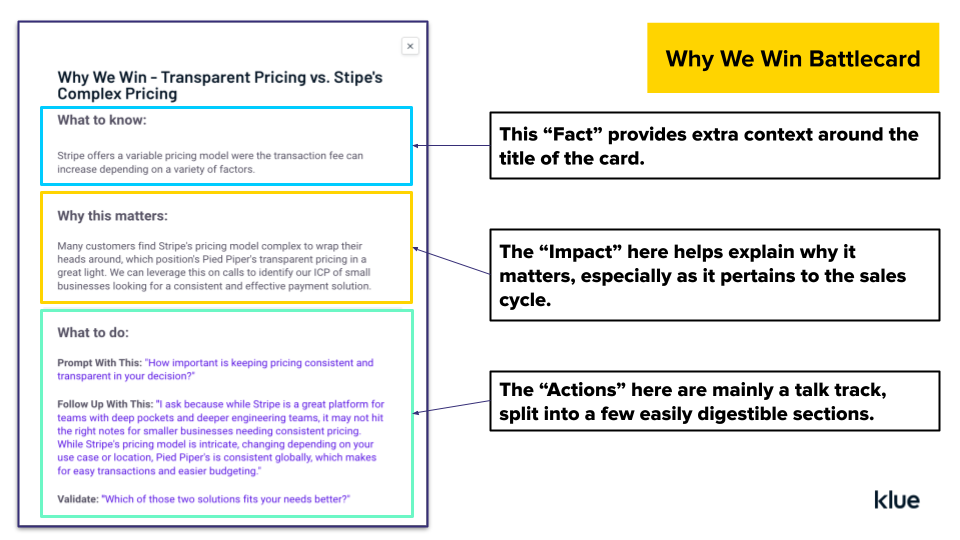
This is what we call the Fact, Impact, Act Framework (FIA) – we highly recommend using this structure (or the COMP-ACT Framework) when building out your cards. Both frameworks add structure, consistency, and actionability to your intel, making it easier to consume and leverage.
Tip: When it comes to sourcing content for a ‘Why We Win’ battlecard:
- Interview sellers who recently won their last 10 deals against specific competitors
- Review your win-loss analysis insights
Sales Battlecard Example #2: Objection Handling Card
The Objection Handling battlecard equips sales reps with strategies to address common competitor-specific objections.
As you can see in the example below, we’re still using the Fact, Impact, Act Framework (FIA). But we’ve adapted the content to fit the specific needs of objection handling.
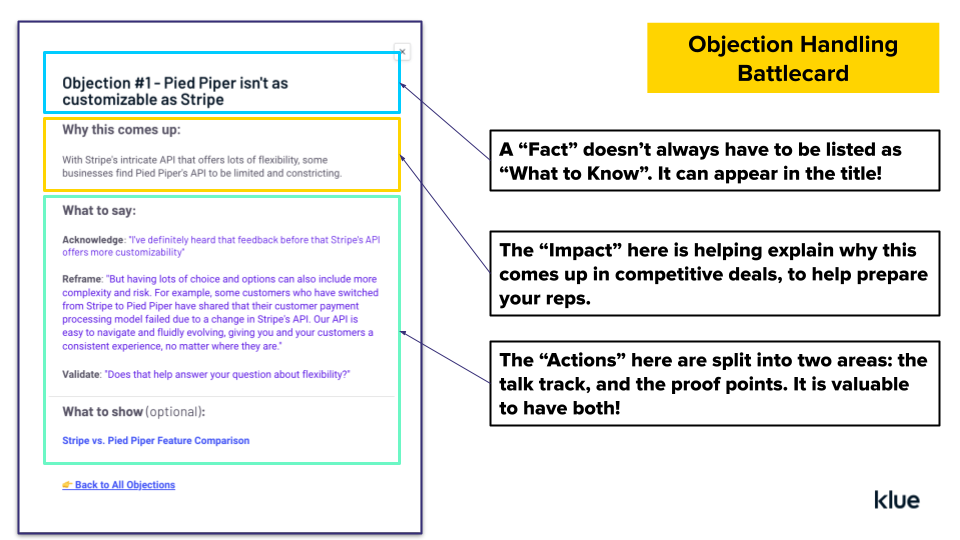
In this example, the fact is introduced in the title of the card itself. Then the impact section explains why this objection commonly arises so that your reps can prepare accordingly.
Finally, the act section of this battlecard is where you choose how to arm your sales rep. For this section, we recommend that you include two things:
- Talk tracks for addressing, reframing, or redirecting objections
- Proof points to substantiate your claims
- One-pagers
- Customer quotes
- Case studies
- Feature comparisons
Creating Your First Sales Battlecard: Getting Started
Building your first sales battlecard can feel daunting.
But fear not, in the first episode of our Competitive Battlecards Mini Course, David Washer, Director of Data Operations at Klue, shared a few critical steps to get you started. Let’s review!
Step 1: Identify Your Audience
First and foremost, identify who you’re creating battlecards for. Ultimately, the content you include will be determined by the needs of your primary stakeholders, whether they’re SDRs, CS managers, or account executives. For example, a veteran seller working on a longer deal may need more in-depth competitive analysis and strategic positioning insights than an SDR.
Step 2: Get Feedback Early and Often
Talk to your sales team and ask them what they truly need to win a deal! Use these insights to identify gaps and quick wins your battlecards can address. Before a full launch, ask a small pilot group of reps to review and provide feedback on your initial battlecards.
Step 3: Source Intel Both Internally and Externally
If you have no competitive content whatsoever, start by exploring the sources of competitive intelligence already at your disposal. This means uncovering ‘tribal knowledge’ among various internal stakeholders and digging into your organization’s existing win-loss information.
Step 4: Tell a Story Rather Than Making a Point
A list of bullet points isn’t going to cut it when your sales rep is handling an objection on a call or preparing to differentiate in an upcoming demo. Instead, re-frame your battlecards to tell a story that reps will remember. We use the FIA Framework to help with this.
Step 5: Keep Your Content Up-To-Date
In the impassioned words of Mr. Washer, “Keeping your content up to date is the most, most, most, MOST important thing to do!”. The moment a seller finds something out-of-date or incorrect in your battlecard, all trust is out the window. Even if intel from a year ago remains relevant, let your team know you’ve verified that it is still true today.
15 More Sales Battlecard Templates to Explore
Finally, we’ve put together a comprehensive library of battlecard examples for you to explore. This library consists of various card types, from commonly used formats to more specialized, niche options.
You can check them out by following the links below.
Like
Comments (0)
Popular
Sign in or Join the community
Because nobody went to school for competitive intelligence.

Create an account
Because nobody went to school for competitive intelligence.
Dive in
Related
22:16
video
3 Characteristics of the Most Highly Adopted Battlecards
By Hunter Sones • Dec 14th, 2022 • Views 962
3:29
video
How to Uncover Competitive Threats with Sales Confidence Surveys
By Andy McCotter-Bickne... • May 22nd, 2025 • Views 14
8:35
video
How Hubspot Builds Battlecards to Support Every Stage of the Deal | Compete week 2023
By Jessica Davis • Nov 13th, 2023 • Views 1.8K
22:16
video
3 Characteristics of the Most Highly Adopted Battlecards
By Hunter Sones • Dec 14th, 2022 • Views 962
8:35
video
How Hubspot Builds Battlecards to Support Every Stage of the Deal | Compete week 2023
By Jessica Davis • Nov 13th, 2023 • Views 1.8K
3:29
video
How to Uncover Competitive Threats with Sales Confidence Surveys
By Andy McCotter-Bickne... • May 22nd, 2025 • Views 14
